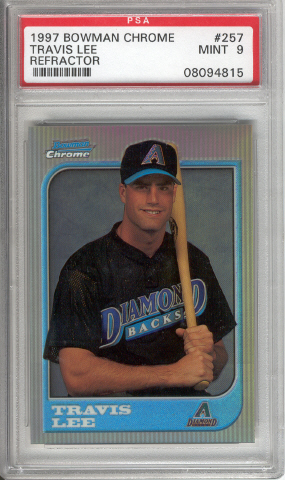Travis Lee


In 1996, the Arizona Diamondbacks were an expansion team that would not start playing baseball for a couple seasons. Therefore, Travis would be given his chance to develop in the minors with no pressure to not produce fast enough. In 1997, produce Travis did. Not only was he playing Gold Glove caliber first base in his first pro season, he hit for power (32 HRís) and his average hovered around .300 all season long. The player tabbed as franchiseís first homegrown phenom was going to be great very quickly. Many envisioned .320, 30+ HRís, and 100+ RBI seasons for years to come from Travis (much like numbers of Hall of Famer George Brett).
In the baseball card world, only Bowman had his rookie in 1997. First came the Bowman rookie, then the Bowmanís Best, and then the infamous Bowman Chrome rookie card. The 1997 Bowman Chrome set was rumored to be scarce and 300 card set was primarily rookie cards. Put rookie cards and scarcity in the same sentence, you have hot and expensive cards right out of the gate. Along with the free agent hype, the Travis Lee 97 Bowman Chrome initially sold from $45-$50; unheard of for a baseball card that just came out in 1997.(See card above)
In the first Arizona Diamondbacks game televised on ESPN, Travis hit a homerun. A fitting beginning for this phenomís major league career. In 1998, Travis Lee hit .269 with 22 HRís and 72 RBI. A solid rookie season. In 1999 (second season) Travis expectations from the club seemed to get the best of him. Major League pitchers were getting him out with regularity and ended his second season hitting .237 with 9 HRís and 50 RBI. While a huge dropoff, many considered this to just be a sophomore slump. In 2000, it only got worse. He was hitting with a low average (below .250) with no power (1 HR) with many at-bats. By the end of the season, the Arizona Diamondbacks All-Star for years to come was traded to the Philadelphia Phillies. His 2000 numbers ended at .235, 9 HRís, and 54 RBI. In 2001, he showed improvement in most areas of his game by hitting .258, 20 HR, and 90 RBI (similar numbers to his rookie season).
In 2002, as many expected, Travis Lee's numbers would decline to a robust (for Lee) .265 average and a not so robust 13 HR's and 70 RBI's for the Philadelphia Philles. In 2003, Travis played for the Tampa Bay Devil Rays with another sure to be future Hall of Famer Ben Grieve (what happened to him???). Travis had one of his best seasons with numbers of .275, 19 HR's, and 70 RBI's.
Many believed that Travis Lee got cheated by getting to the big leagues so fast and that he will never be the player he could have been. He may unfortunately not be the next George Brett, but he plays consistently every year and is a great first baseman. Although defense does not count in fantasy leagues, if your in late rounds and need a first baseman, you know what to expect from Lee!
If your into nostalgia, go to a card shop and pay the buck for the Bowman Chrome rookie. You will be glad you did.